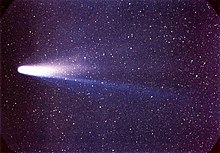Periodic comet
A periodic comet is a comet which orbits around the Sun. A short-period comet will complete its orbit in less than 200 years.[1] A long-period comet will take more than 200 years to orbit.[1] In most cases the comets are named after the person who discovered them.[1] The Shoemaker-Levy comets were named after Eugene Shoemaker, Carolyn Shoemaker and David Levy.[2] A few comets are named after the person who calculated the orbits, such as 2P/Encke and 27P/Crommelin. It is very difficult to work out the orbit of a long-period comet because the orbit changes. The gravity of planets, or the release of gas or material from the comet itself, changes the orbit. Short-period comets can be predicted very accurately.

Periodic comets sometimes have the same name, for example there are nine Shoemaker-Levy comets and twenty-four NEAT comets. The Minor Planet Center, a part of the International Astronomical Union gives comets a different number prefix or uses the full title such as 181P/Shoemaker-Levy and 192/Shoemaker-Levy which are both "Comet Shoemaker-Levy". Sometimes an informal numbering system is used for periodic comets so 181P is Comet Shoemaker-Levy 6 and 192P is Comet Shoemaker-Levy 1. Because non-periodic Shoemaker-Levy comets are included in the number sequences there appear to be gaps in the numbers, for example C/1991 B1 is between Shoemaker-Levy 2 and 3, C/1991 T2 is between 5 and 6, C/1993 K1 and D/1994 E2 after Shoemaker-Levy 9.
In naming a comet, the letter before the "/" is:
- "C" for a non-periodic comet[3]
- "P" is a periodic comet[3]
- "D" is a comet which has been lost or has disintegrated[3]
- "X" is a comet for which no reliable orbit could be calculated –usually historical comets[3]
- "A" for an object that was thought to be comet, but is actually a minor planet.[3]
Some lists keep the "C" prefix for comets of with orbits longer than about 30 years until their return is confirmed.[4]
References
change- ↑ 1.0 1.1 1.2 "Comet Facts, Characteristics & Formation". space.com. 2011. Retrieved 27 June 2011.
- ↑ Whitehouse, David (28 July 1999). "BBC News | Sci/Tech | Moon burial for geologist". BBC News. London: BBC. Retrieved 27 June 2011.
- ↑ 3.0 3.1 3.2 3.3 3.4 "Cometary Designation System". minorplanetcenter.net. 2011. Retrieved 27 June 2011.
- ↑ "Comet names and designations". icq.eps.harvard.edu. 2011. Retrieved 27 June 2011.
Related pages
changeOther websites
change- "Periodic Comet Names List". pdssbn.astro.umd.edu. 2010. Archived from the original on 30 May 2010. Retrieved 27 June 2011.